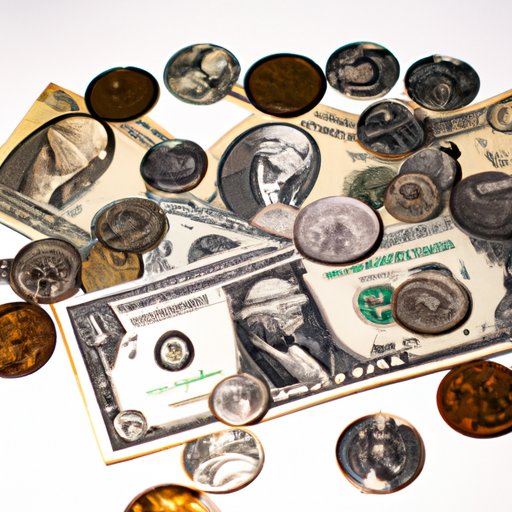
Introduction
Have you ever wondered what US money is made of? Sure, you might know that it’s made of paper and metal, but there’s much more than meets the eye. In this article, we’ll explore the art and science of US currency, from its composition to its historical evolution, and everything in between.
The Composition of US Money
US currency is a blend of materials designed to give it durability, security, and a unique look and feel. Paper bills are made of a blend of 75% cotton and 25% linen, making them more resilient and less prone to tearing and wear. The ink used to print bills contains color-changing pigments that give it a shifting color effect, making it hard to counterfeit.
Coins, on the other hand, are made of a variety of metals, including copper, nickel, and zinc. The composition of coins varies depending on the denomination, with higher-value coins typically containing more valuable metals.
Everything You Need to Know About US Money
US currency is loaded with features that make it easily identifiable and unique. Portraits of notable figures, symbols of national landmarks, and even serial numbers all have their place on US bills. Each of these elements has a historical background and significance, reflecting the country’s cultural heritage and values.
For example, each bill’s portrait depicts a notable figure in American history, such as George Washington on the $1 bill and Benjamin Franklin on the $100 bill. Similarly, the back of each bill features symbols and images that represent American values, such as the American eagle and the Statue of Liberty.
The Secrets of US Bills
The blend of materials used to make US paper currency is carefully calibrated to give bills a unique feel and durability. Cotton and linen are chosen because they are strong, absorbent, and readily available. In addition, the ink used on bills contains microscopic threads that glow under ultraviolet light, making it easier to authenticate.
US paper currency also has a unique printing process that uses intaglio printing, a method that involves engraving an image into a metal plate and then pressing it onto paper. This technique creates raised lines and textures that can be felt by touch, making it harder to counterfeit.
Breaking Down the Composition of US Coins
US coins are made of a variety of metals, with each metal offering unique properties. For example, copper is used for pennies because it is a good conductor of heat and electricity, while zinc is used in combination with copper for other denominations because it is lighter and cheaper.
Nickel is used in some coins because it is highly resistant to corrosion and wear, while silver and gold are used in collectible coins to add value and rarity. The composition of coins has been subject to change throughout history, with some coins even being made entirely of other materials, such as steel during World War II.
The Art and Science of Making US Money
Designing and producing US currency is a highly specialized process that involves a combination of art and science. The process begins with creating a design for a bill or coin using advanced software and printing technologies.
Once the design is approved, it is transferred to an engraving department where it is etched into a metal plate using lasers and other tools. The plates are then used to print bills and coins using specialized printing presses that can produce tens of thousands of bills per hour.
The Historical Evolution of US Money
US currency has a long and storied history that dates back to colonial times. The first paper currency was issued during the Revolutionary War to help finance the war effort, and the first coins were minted shortly thereafter.
Over time, the design and security measures of US currency have evolved to combat counterfeiting and reflect changing cultural values. From adding microprinting and holographic strips to redesigning bills to feature new portraits and symbols, the US government has worked tirelessly to make US money more secure and reliable.
The Role of Bureau of Engraving and Printing
The Bureau of Engraving and Printing (BEP) is responsible for designing and producing US currency, including paper bills and coins. The BEP employs hundreds of designers, engravers, and printers who work together to create some of the most intricate and secure currency in the world.
In addition to its manufacturing responsibilities, the BEP is also responsible for combating counterfeiting. The bureau works together with law enforcement agencies and financial institutions to share information and develop new security features that make it harder for counterfeiters to create fake money.
Conclusion
US currency is an intricate blend of materials, features, and security measures that make it one of the most secure and reliable currencies in the world. From the cotton-linen blend of paper bills to the unique composition of coins, every element of US money is designed to be durable, functional, and easily identifiable.
The history of US currency is fascinating, reflecting cultural values and historical events that have shaped the country. We hope this article has shed some light on the art and science of US money and encourages readers to take a closer look at the bills and coins in their wallets.




